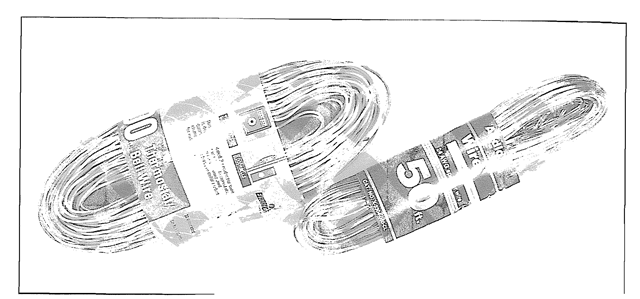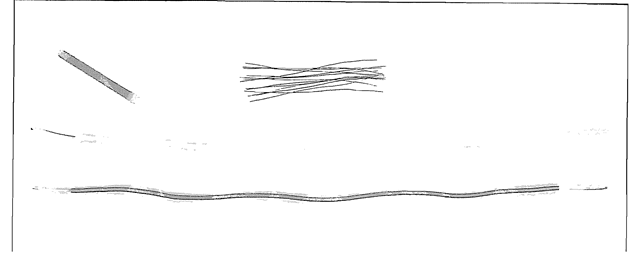You can make a paper-match igniter (Figure 17-1) right at the launch site. You can use it immediately, and you can bring the materials with you.
MATERIALS LIST
1. A hank of thermostat-doorbell wire 4. A roll of 3/4″ masking tape
2. A short length of stereo speaker wire 5. A single edge razor blade
3. A topic of paper matches 6. A pair of sturdy pliers
Thermostat-doorbell wire and stereo speaker wire (Figure 17-2) are sold by the foot and by the roll at hardware stores. The doorbell wire is made from a twisted pair of stiff, single strand wires with red and white plastic coatings. The stereo speaker wire looks like regular lamp cord, but it’s thinner. It is typically called “18-2″. It is also coated with plastic, and the wire inside is fabricated from multiple strands of very thin wire, which you can unravel, and use for the fuse wires in these igniters.
1. Separate an 8″ length of doorbell wire into a red and a white strand. Then strip the ends of each strand back about 1/2″. I call these strands “lead wires” (pronounced “feed”). Strip the plastic from the end of a length of stereo speaker wire, and cut the multistrand wire inside into a pile of single strands about 2″ long. Hereafter I’ll call these thin, bare wires, “fuse wires”. Cut or tear off a single paper match, and cut a 3/4″ square of masking tape (Figure 17-3).

Figure 17-2. Hanks of doorbell wire (left) and stereo speaker wire (right). You can buy them at a hardware store.

Figure 17-3. Two lead wires, a pile of fuse wires, a paper match, and a piece of masking tape. These are the things you’ll need to make a paper-match igniter.
2. With the pliers, pinch a little flat spot on one end of each lead wire. Pick up a lead wire in one hand, and a fuse wire in the other. Then twist one end of the fuse wire around the flattened end of the lead wire with 3 to 4 wraps. The flat spot keeps the fuse wire from slipping off. Switch the assembly you’ve just made to your other hand. Pick up the second lead wire, and wrap the free end of the fuse wire around the flattened end of this second lead wire. The result should be a red and a white plastic-coated lead wire connected by a thin, bare fuse wire (Figure 17-4).
3. With a single edge razor blade, cut a slit in the tip of the paper match (Figure 17-5 ). If the match tip crumbles when you cut it. throw away the crumbly match. Hold a new match up to your mouth, and breathe on it for 30 seconds. The moisture in your breath will soften the tip. and the composition on the tip will then cut cleanly and smoothly. Fold the wire assembly that you made in step 2 down over the match so that the fuse wire passes through the slit in the match’s tip. and the two lead wires are separated by the match’s paper stem (Figure 17-6).
4. Wrap the whole thing together with the square of masking tape. Then twist the lead wires together, and the igniter is finished (Figure 17-1).
These single paper-match igniters fit perfectly into the cores of rocket motors with 1/4″ and 5/16″ dia. nozzle throats. For larger motors, tape on extra matches (Figure 17-7 ). A paper-match igniter should have enough matches to insure a certain ignition, yet fit loosely into the core of the motor for which it was made.
![tmp69-36_thumb[1] tmp69-36_thumb[1]](http://lh3.ggpht.com/_X6JnoL0U4BY/S2tCo3ogSAI/AAAAAAAANJE/ILNZcBFFmNM/tmp6936_thumb1_thumb.png?imgmax=800)
![tmp69-37_thumb[1] tmp69-37_thumb[1]](http://lh6.ggpht.com/_X6JnoL0U4BY/S2tC2ybvcSI/AAAAAAAANJM/BLv2Kpx3l6U/tmp6937_thumb1_thumb.png?imgmax=800)
A Paper-Match Igniter (Rocket Motor)
Next post: A High-Heat Igniter (Rocket Motor)
Previous post: ELECTRIC IGNITERS and a HOMEMADE IGNITION SYSTEM (Rocket Motor)
